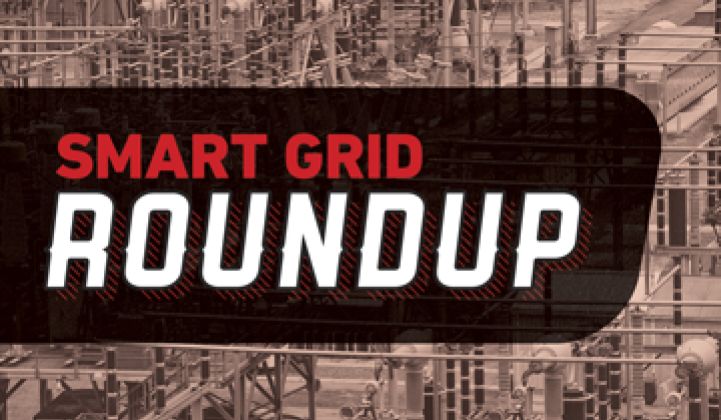Combating global warming is going to require a huge influx of green power onto the grid, both at the large scale (think giant wind farms or solar power plants) and at the fragmented, distributed scale (think rooftop solar panels, on-site cogeneration systems, factory and hospital backup power systems, and even battery-based grid energy storage systems).
Using all those distributed assets to match power use to wind and solar power’s intermittency, either locally or on a grand scale, is a massive challenge, but one that we need to solve if we’re to come close to reaching our collective greenhouse gas reduction targets. Over in the U.K., Western Power Distribution’s “Project FALCON” (Flexible Approaches to Low Carbon Optimized Networks) is tackling this challenge, and recently tapped General Electric for grid-scale batteries to add to the mix.
GE will supply five of its 100-kilowatt Durathon batteries to Western Power Distribution (WPD), which will install them at substations and tie them into its distribution management system (DMS). Over the course of the four-year project, the utility plans to test out the devices' abilities to “enhance network efficiency through voltage support, improved power quality and electrical noise reduction,” as well as to defer expensive capital improvements.
That’s a pretty standard list of the functions utilities want out of their grid batteries, but you’ll notice that it doesn’t include long-term energy storage -- batteries are still far too expensive for that. Instead, WPD wants to use the batteries to manage overall grid quality issues, which requires sophisticated and fast-reacting battery control systems to achieve.
GE is working with Austin, Texas-based startup Xtreme Power as its battery management software (BMS) provider. Xtreme recently announced it was selling its own battery factory to focus on BMS deployment with GE, Samsung SDI, and other battery providers. Grid-scale batteries are expensive, and if they’re to be rolled out at commercial scale, they’ll have to come with ten-year-and-up warranties to satisfy utility capital investment plans.
WPD serves about 7.7 million customers across the Midlands, southern Wales and Cornwall, and is tapping a host of smart grid tech providers to test out how they can help solve the power quality and management problems that emerge with lots of green power coming onto the grid. In the long run, project partners, including the U.K. Office of Gas and Electricity Markets’ (Ofgem’s) Low Carbon Network Fund, intend to develop a new computer-based modeling tool for managing all of this new intermittency and grid instability, as well as the systems built to monitor and control it all.
Carbon reduction targets and green energy integration are also big challenges for Canada’s Ontario province. Ontario is seeing a boom in solar and wind installations, funded by generous feed-in tariffs meant to keep the province entirely off coal-fired power. It’s also one of the first jurisdictions to roll out both smart meters and time-of-use energy pricing to all its customers, and is looking at ways to measure their effectiveness.
Canadian home energy management company Energate recently launched a project with Ontario’s Ministry of Energy and a long list of utilities, meant to test multiple homeowner-utility technology connections and their impact on the grid. As part of the $7.8 million Consumer Engagement for the Smart Grid (CESG) program, Energate will be rolling out smart thermostats, in-home gateways and a host of customer-facing mobile and web-based applications to up to 1,000 homes over the coming months.
Participating utilities include Cambridge & North Dumfries Hydro, Kitchener-Wilmot Hydro, Waterloo North Hydro, Hydro One, Hydro Ottawa, Peterborough Utilities, PowerStream, and Veridian Connections -- an interesting list of big and small energy companies, all tying into the province’s overarching smart meter and smart grid data management framework.
Energate has a long list of utility customers and smart grid partners, including Silver Spring Networks and Oklahoma Gas & Electric on a 40,000-customer smart meter network-enabled residential demand response program. It recently announced it’s working with GE’s PowerOn demand response platform as well.
While millions of homes add up to a lot of energy efficiency and carbon reduction potential, there’s also a lot of energy to be saved and emissions reduced on the big industrial side of the grid as well -- including the oil and gas industries themselves.
Schneider Electric would appear to see opportunity in that sector, judging by Monday’s news of it taking a complete ownership stake in Russian medium-voltage grid player Electroshield – TM Samara. Schneider has owned half the company since 2010, but went all in to capitalize on Electroshield’s market share in Russia and abroad, and particularly its “market access to the oil and gas, utilities and mining, minerals and metals industries,” the company stated.
Big oil is a world unto itself, but there are opportunities for green technologies to make their mark. Oil giant Shell just announced it is looking to invest roughly one-quarter of a “several-hundred-million” dollar venture capital fund in “future energy” technologies, ranging from solar-thermal power for enhanced oil recovery to big data software to help it turn geological data into new discoveries.
Schneider Electric has been buying a lot of smart grid companies lately, as have its competitors like Siemens, ABB, General Electric, Alstom, Eaton/Cooper Power, Hitachi and Toshiba, to name some of the more acquisitive grid giants over the past few years. Europe’s distribution grid markets also have their share of mid-sized players vying for market share via acquisitions of their own, such as Spanish company Ormazabal, which recently bought U.S. smart grid company Current to absorb its stake in a key European smart grid communications standard called PRIME.



